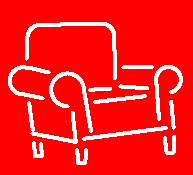 The Empty Chair-Gestalt Theory at Work
The Empty Chair-Gestalt Theory at Work

The Theory Behind the "Empty Chair"
-
The "Empty Chair" technique is one of the
various ways in which Gestalt Therapy can be applied in school counseling.
Developed and popularized by Frederick "Fritz" Pearls, Gestalt therapy
"appeals to school counselors because it is based on perceptual psychology
and the assumption that people respond to various levels of awareness"
(Myrick, 91).
-
In Gestalt therapy, counselors challenge clients
with questions so that the client increases their awareness of feelings
and develops a stronger ability to face daily-living situations and problems.
-
Some of the most basic interventions in Gestalt
Counseling include repeating significant statements, exaggerating gestures
for clarification, focusing on the relationship between the client's verbal
and nonverbal behavior, and acting out both sides of a dialogue ("Empty
Chair"), to help the client learn more effective means of coping and to
assume more responsibility for the activities of their life.
-
The emphasis is on what is being done, thought,
and felt at the moment ("here and now"), rather than on what occurred in
the past, or what might be, could be, or even what should be.
-
The counselor teaches the client that what
is directly experienced and felt is more reliable than explanations or
interpretations based on pre-existing experiences or attitudes.
-
According to Yontef & Simkin, "awareness
and dialogue are the two primary tools in Gestalt therapy" (1989). They
define awareness as the experience being in touch with one's own actions,
feelings and overal existence. Awareness then, implies knowing that one
has control over, choice of, and responsibility for one's own feelings
and behavior. The person who is aware knows what he does, how he does it,
that he has options and alternatives, and that he chooses to be the way
he is. Awareness provides an opportunity for change. In experiencing different
options, the client gains the freedom of choice. Change then happens by
itself in a natural way. Awareness is the the ultimate goal and the path
of Gestalt therapy.
-
Responsibility is also an important aspect
of Gestalt therapy. Responsibility is understood, according to Yontef and
Simkin, as the "ability to respond" (1989) rather than react. It
requires awareness, acknowledging and owning our process. When we recognize
how we contribute to a situation we increase our personal power to change
the outcomes rather than feeling like victims.
-
Perls' work noted that many of us split off
our experience (thoughts, sensations, emotions) that are uncomfortable.
The objective of his work is to move people into owning their experiences
and developing into a healthy gestalt (or whole). The Gestalt therapy emphasis
on personal responsibility, interpersonal contact and increased clarity
of awareness of what is, could be of great value in meeting the problems
of the present. One example is application of Gestalt therapy in schools
(Brown & Lederman, 1970 as cited in Yontef and Simkin, 1989).

The Role of The Counselor in Gestalt
Counseling
 |
-
The Gestalt counselor works by engaging in
dialogue rather than by manipulating the patient toward some goal.
-
The function of the Gestalt counselor is to
raise awareness, which is defined as knowing what one is sensing, feeling,
and thinking. Such awareness can be achieved only in the "now," the present
moment. The counselor assists the client to become aware of "what" and
"how" he or she behaves in the moment.
-
Gestalt therapy fosters change primarily by
the patient's learning to understand himself or herself in the world through
insight.
|

The Empty Chair Approach

|
The "Empty Chair" technique is typically
used with interpersonal problems (i.e. a client angry at someone else,
feels too submissive, lonely, etc.) It is a kind of to role playing, but
in this case, the client plays both roles. Employing two chairs,
the counselor asks the client to change places as the conversation unfolds.
"The actual acting and movement helps the client to get in touch with deeper
sensimotor emotions" (Ivey & Ivey, 300). |
-
Rather than passively awaiting the therapist's
responses and subsequent change, the client is seen as a collaborator who
is to learn how to self-heal. The counselee is taught the difference between
talking about what happened 10 minutes ago (or last week or last year))
and experiencing what is happening now. Unlike most other therapies, in
Gestalt therapy the process of self-discovery through experimentation is
the end point rather than the feeling or idea or content. All techniques
in this type of intervention are elaborations of the question, "What are
you aware of (experiencing) now?" and the instruction, "Try this experiment
and see what you become aware of (experience) or learn." ( Yontef &
Simkin). Many techniques are as simple as asking what the client is aware
of, or what he is feeling or thinking at the moment. A subsequent
technique is to follow an awareness report with the instruction: "Stay
with it" or "Feel it out." "Stay with it" encourages the patient
to continue with the feeling that is being reported, which builds the patient's
ability to further explore a feeling through to completion.
-
In one study Greenberg examined the use of
the two-chair technique to resolve splits. He defined a split as "a verbal
performance pattern in which a client reports a division of the self process
into two partial aspects of the self or tendencies." (323, as cited in
Yontef & Simkin, 1989). He concludes that the two chair technique facilitates
an increase in the client's depth of experiencing and often leads to resolutions
of splits among people seeking counseling.

Example
The following is an example of
how a school counselor might use Gestalt's "Empty Chair" technique to help
a student in individual counseling deal with his reaction to his parents'
divorce. Andrew, our fictitious student is angry at his father for leaving
him and his mother. Realizing that Andrew is also experiencing a lot of
guilt, the counselor decides to employ Gestalt counseling to help him increase
self-awareness and realize that he has control over, choice of, and responsibility
for those feelings. This intervention will adhere to the framework outlined
by Martin S. Fiebert in Stages
in a Gestalt Therapy Session: An Examination of Counselor Interventions
|

|
-
Stage One:
The first session(s) should aim at finding
out where Andrew is, rather than where the counselor may think he is. After
the introductions and relationship building stage, the counselor will attempt
to focus Andrew's attention to his immediate experience-the what and how
of behavior-and away from speculations as to causes. The counselor approaches
this first phase by exploring what the student is currently experiencing
in awareness. During this process, the student is guided and encouraged
to experience the connection between his verbal and non-verbal behaviors,
for example, breathing patterns, posture, hand gestures, or tone of voice.
The counselor also tries to train the student to accept increasing responsibility
(ability to respond, not react) to individual thoughts, sensations, feelings,
by asking him to restate and repeat particular sentences or expressions,
e.g. substituting "won't" for "can't," "want" for "should," and "I" for
"it," and presenting all expressions in the present tense (Fiebert, 1990)
-
Stage Two:
After Andrew has learned to focus on awareness
and express feelings and sensations in the present, the counselor will
ask him to explore his conflict by having an external dialogue with his
father. Employing two chairs, Andrew is now asked to converse with his
father-the person with whom those feelings are currently experienced. The
counselor will be paying special attention to the verbal/non-verbal discrepancies
in the student and help him become aware of their connection and may ask
Andrew to act out some of his feelings of anger.. In the closing of this
phase. Andrew should become quite immersed in the process of self discovery
and need little overt guidance to switch between chairs, appropriately
express feelings, and monitor his own behavioral patterns. The goal of
this phase is to have Andrew express: (a) what are the issues and feelings
he is experiencing in his relationship with his father; (b) what are the
hidden feelings perceived in the relationship; and, (c) what are the desired
solutions to the stated situation.
-
Stage 3:
During phase two the counselor might have
witnessed Andrew's inner conflict emerge with increasing power as his thoughts,
feelings of guilt, and bodily responses associated with anger come into
awareness. A variation of "The Empty Chair" technique can be used in this
stage again. The counselor may ask Andrew to establish a dialogue with
himself, to explore this internal tension. For this stage to be successful,
Andrew must recognize that the conflict being explored in the external
dialogue with his father can also be understood and more effectively resolved
as a reflection of a deep internal tension within himself. The accomplishment
of this critical shift in self understanding requires a sufficient amount
of objective awareness on the part of Andrew. Thus, if Andrew is totally
immerse in the external problem and still blaming his father (i.e. not
taking responsibility for the way he is feeling) he may feel frustrated
and confused if the counselor tries to shift to this part of the exploring.
According to Fiebert, the central focus of activity at this stage is a
growing confrontation between two significant and opposing aspects within
the Andrew's personality (1990). Andrew is both angry at his dad and feeling
guilty about his anger. The more he can experience, understand, and become
aware of each pole of tension, the more likely he will be able to resolve
it. Thus, counselor behavior is directed at helping Andrew identify and
own each aspect of his inner conflict.
-
Stage 4:
Pearls calls this state "Integration"
(Yontef, 1989). During this phase, if the intervention has been successful,
Andrew should be more aware of what his is doing, how he is doing it and
how he can change himself-and at the same time, learn to accept and value
himself. In other words, he should be able to experience a feeling of having
gotten in touch with all aspects of his own self.

Advantages and Limitations
 |
-
According to Mortola, "the Gestalt perspective
offers a respectful approach to facilitating child development in the therapeutic
context by acknowledging and enabling a child’s "self-regulatory" process
of moving through periods of developmental disequilibrium and organismic
growth and change" (Sharing
Disequilibrium: A Link Between Gestalt Therapy Theory and Child Development
Theory). This is seen as a positive because the role of the counselor
is seen as that of a facilitator in the child's own process of self-awareness,
rather than trying to manipulate him to some specific goal. The goal of
this type of counseling is exploration rather than change, although change
may naturally occur as awareness increases. As the child or adolescent
becomes more aware of alternatives and options, he becomes better prepare
to make choices and decisions and act responsibly.
-
An experiment applying Gestalt methods to
reduce test anxiety in students, Shraga Serok reports that Gestalt activities
introduced in the experiment caused the effect of lowering the level of
anxiety for workshop participants (The Application of Gestalt Methods for
the Reduction of Test Anxiety in Students, 1991).
|
-
Among the limitations, it should be cited
children's need to please adults; therefore, they may tend to say what
they think the counselor expects, rather than what they are actually experiencing.
It may also difficult for a young child to understand the concept that
he or she is responsible for determining his or her own behavior; thus
changing statements that blame others into statements that place responsibility
on him may not be as easy as it would for an adult. In addtition, a young
child may not be prepared to talk about feelings as they are experienced
in the present, so a counselor must work hard to keep his or her experiences
in the "here and now." Therefore, age can be viewed as a limitation when
using this type of intervention in the schools.
Conclusions and Recommendations
 |
People, according to Gestalt therapy, are
responsible, that is, they are the primary agents in determining their
own behavior. When people confuse responsibility with blaming and shoulds,
they pressure and manipulate themselves; they are not integrated and spontaneous.
Gestalt therapy is an exploration rather than
a direct modification of behavior. The goal is growth and autonomy through
an increase in consciousness. Rather than maintaining distance and interpreting,
the Gestalt counselor guides active awareness work.
|
-
Counselees can see, hear and be told how they
are experienced, what is seen, how the therapist feels, what the therapist
is like as a person. Growth occurs from real contact between real people.
-
The general approach of Gestalt therapy is
to facilitate exploring in ways that maximize what continues to develop
after the session and without the therapist. The patient is often left
unfinished but thoughtful or "opened up," or with an assignment. This is
in part how Gestalt therapy can be so intensive on fewer sessions per week.
The counselor gives the degree of facilitation necessary to foster
patient self-improvement and growth.
-
Of course, these techniques may not work with
all clients. Each client is unique and the counselor should pay special
attention when choosing interventions. They should take into account the
counselee's level of cognitive development, as well as his/her ability
to understand and actively participate in the counseling process.

References
Fiebert, M. S. (1990). Stages in Gestalt
Therapy Session and An Examination of Counselors Interventions.
Retrieved
on July 2, 2002, from California State University: http://www.csulb.edu/~mfiebert/gestalt.htm
Ivey, A. E. & Mary B. (1999). Intentional
Interviewing and Counseling.Pacific Grove, CA: Brooks/Cole
Publishins Company.
Myrick, R. D. (2003).
Developmental
Guidance and Counseling.Mineneapolis, MN: Educational Media
Corporation.
Mortola, P. (2001) Sharing Disequilibrium:
A Link Between Gestalt Therapy Theory and Child Development
Theory: Gestalt
Review. Behavior on Line, 5, 45-56.
Retrieved July
2 2002, from http://www.gisc.org/gestaltreview/2001/mortola.html
Serok, S. (Summer 91).
The Application
of Gestalt . Assessment& Evaluation in Higher Education, Volume
2,
157 (Abstract).
Yontef, G. & Simkin, J. (1993).
An Introduction to Gestalt Therapy. Behavior on Line. Retrieved July 2
2002, from http://www.behavior.net/gestalt.html
 The Empty Chair-Gestalt Theory at Work
The Empty Chair-Gestalt Theory at Work
![]()
![]()

![]()

![]()

![]()


![]()